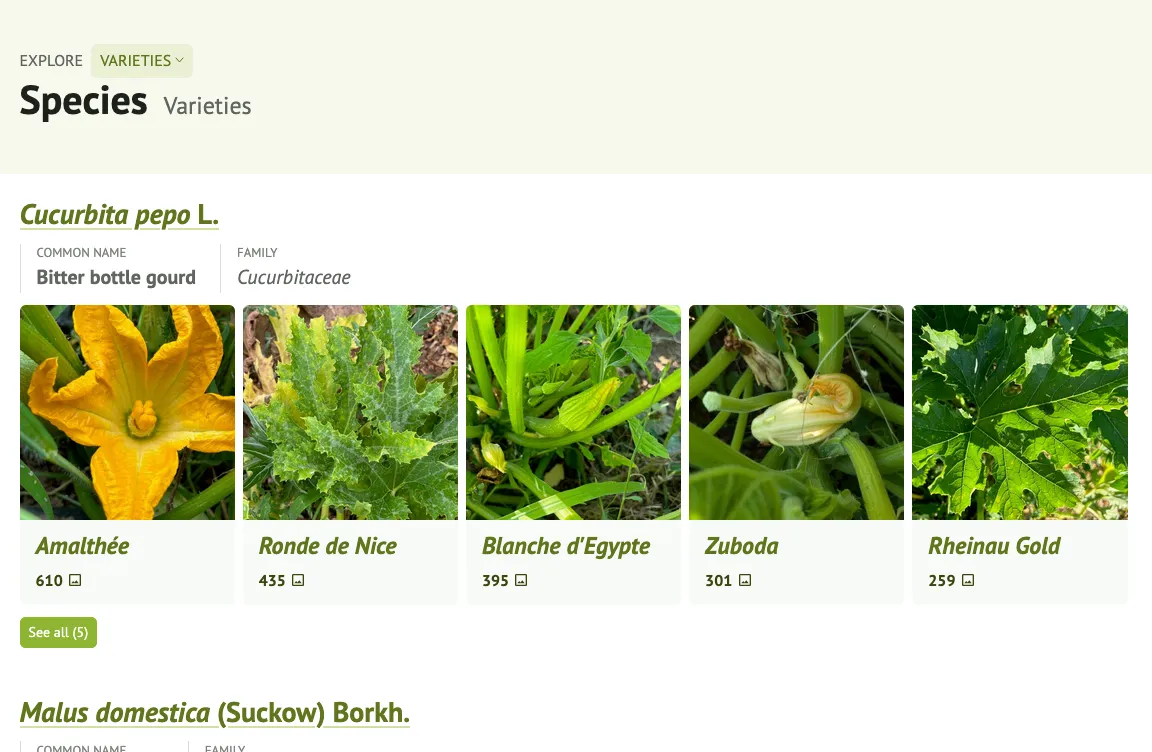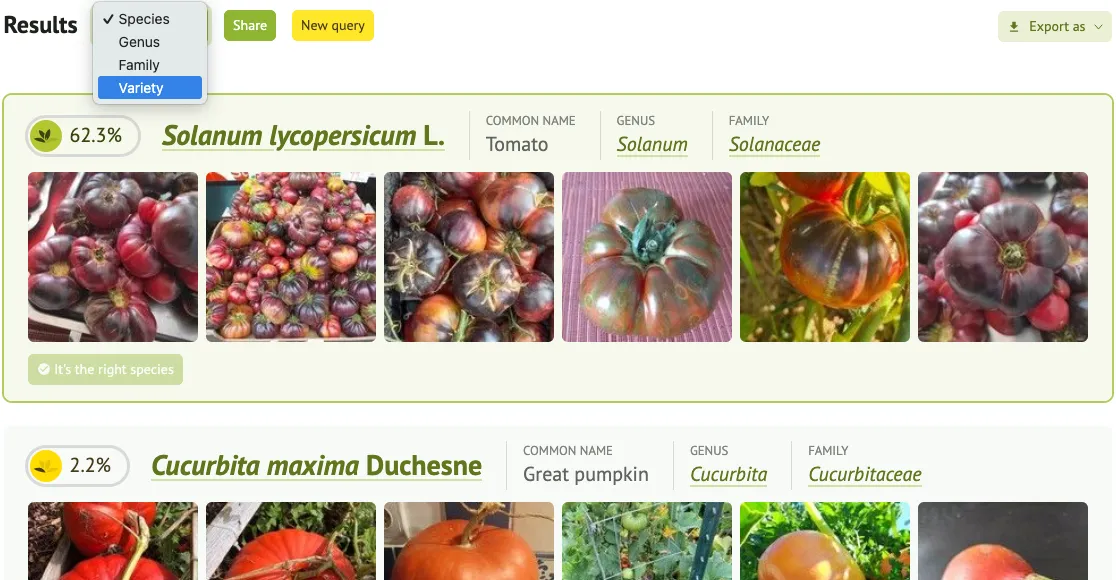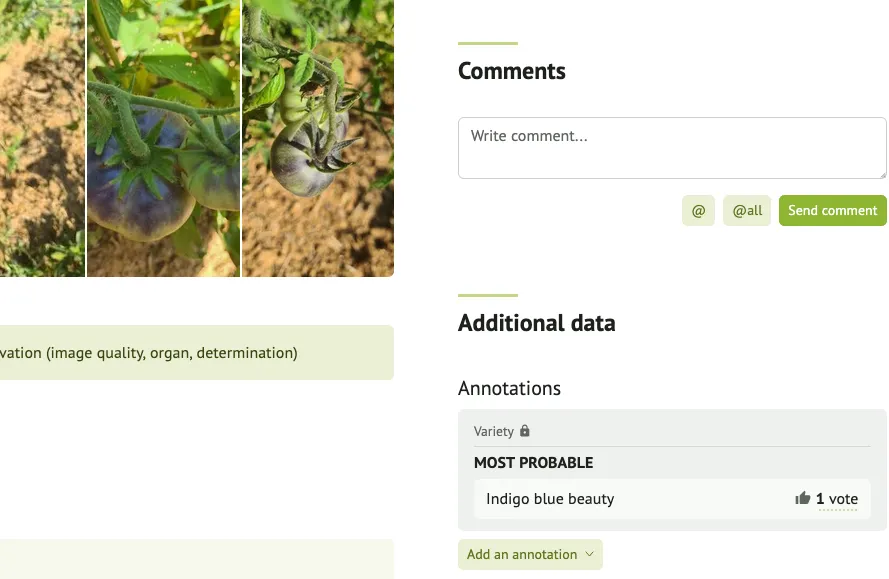Variety Identification
We are pleased to introduce a new beta feature in the Pl@ntNet application focused on plant variety identification, with a particular emphasis on cultivated species such as tomato, citrus, cucumber, zucchini, and others. Pl@ntNet is known for species-level identification, but this new feature goes further: it aims to recognize specific varieties or cultivars within a species based on visual characteristics.
This feature is currently limited to a small number of well-documented crops and varieties. By analyzing characteristics such as the shape, color, and size of fruits, as well as leaf morphology from images, Pl@ntNet provides preliminary suggestions on the most likely variety. These results are generated using models trained on datasets of labeled varieties.
As with all beta features, predictions are experimental and should only be used for informational purposes. Your feedback and contributions are essential to help us improve accuracy and expand the scope of this tool in future versions.
How can I access this new feature?
Section titled “How can I access this new feature?”To access this beta feature, we need to authorize your Pl@ntNet account. Please fill out the following form: https://forms.gle/BYH7WC9d8eJEm3dk9. We will inform you as soon as your access has been granted, usually within 3 business days.
To go further
Section titled “To go further”Help us cover more species: share your datasets!
Section titled “Help us cover more species: share your datasets!”If you are an expert Pl@ntNet user and have access to high-quality images showing plant varieties (with reliable annotations), we would be delighted to receive your help! The contribution of such datasets can significantly improve the accuracy and coverage of our new variety identification function. If you wish to share data or collaborate, please do not hesitate to contact us (mentioning it in the comment field of the form) - we are happy to co-build this feature with the community.
Which species are already covered?
Section titled “Which species are already covered?”As of April 2025, we cover:
-
Cucurbita pepo - Zucchini
-
Malus domestica - Apple
-
Pachylobus edulis - Safou
-
Solanum lycopersicum - Tomato
-
Solanum melongena - Eggplant
We are continually importing new data to cover a greater number of species, so don’t forget to visit this page for an updated overview of all currently supported species: https://identify.plantnet.org/varieties/species/tags/variety.
Explore plant variety observations
Section titled “Explore plant variety observations”With this feature, users will also be able to explore observations of different plant varieties shared by the Pl@ntNet community. These examples offer a visual reference for distinguishing the characteristics of cultivars, such as differences in fruit color, shape, or growth. Whether you are looking to identify a specific variety or simply learn more about cultivated diversity, these annotated observations are a valuable and growing resource.

Identify plant varieties
Section titled “Identify plant varieties”In addition to consulting observations, this feature allows you to identify specific varieties directly from your own images. By uploading a photo of a variety of a plant that we cover (see the list above), Pl@ntNet will analyze the image and suggest possible results.
Variety identification is available at the following address: https://identify.plantnet.org/varieties/identify and works almost the same way as the classic Pl@ntNet identification you are used to. In addition to species identification, Pl@ntNet will also propose a set of varieties for each species.
For now, variety identification cannot be shared on the platform like the usual plant observation to prevent potential determination errors from spreading in our datasets.

Variety identification is also available in the beta version of the identification page (see the screenshot below to switch to the beta version), regardless of the selected flora. You can use the dropdown menu at the top of the identification results to switch between suggestions at the species, genus, family and variety level.


Annotate existing plant observations with variety information
Section titled “Annotate existing plant observations with variety information”As part of this beta release, you will also be able to annotate existing plant observations with variety information. If you recognize a specific variety of a plant, you can add or suggest annotations to enrich the database. These contributions are essential to improve the accuracy of the identification function and build a more complete resource for the entire Pl@ntNet community.
An observation can receive a set of annotations. To annotate an observation, select the “Variety” annotation (only accessible on your own observations) in the Annotations section of the right sidebar and search for a specific value. If the variety you identify in your image is absent from the list and you have more than 10 images illustrating it, please contact us here.
